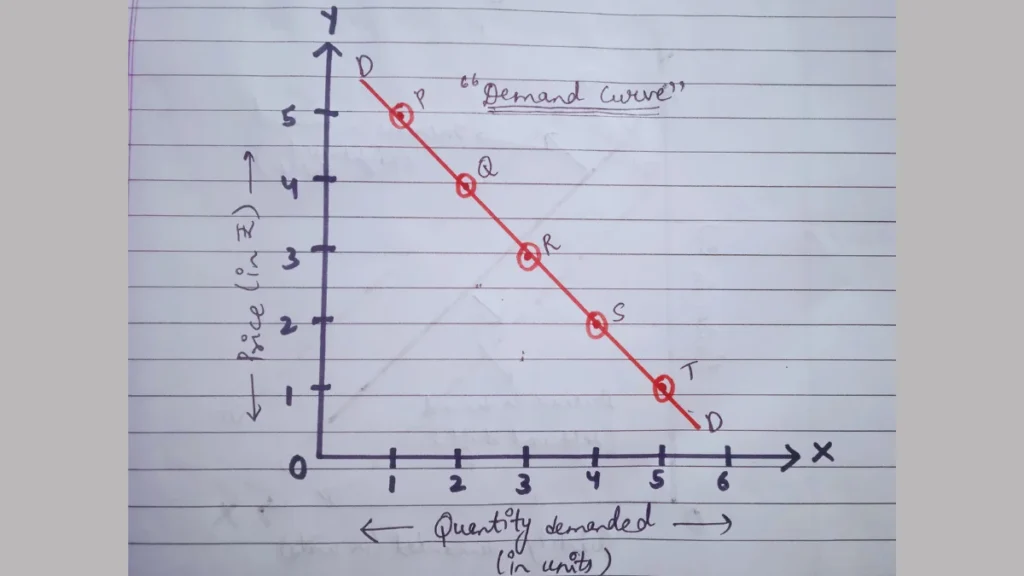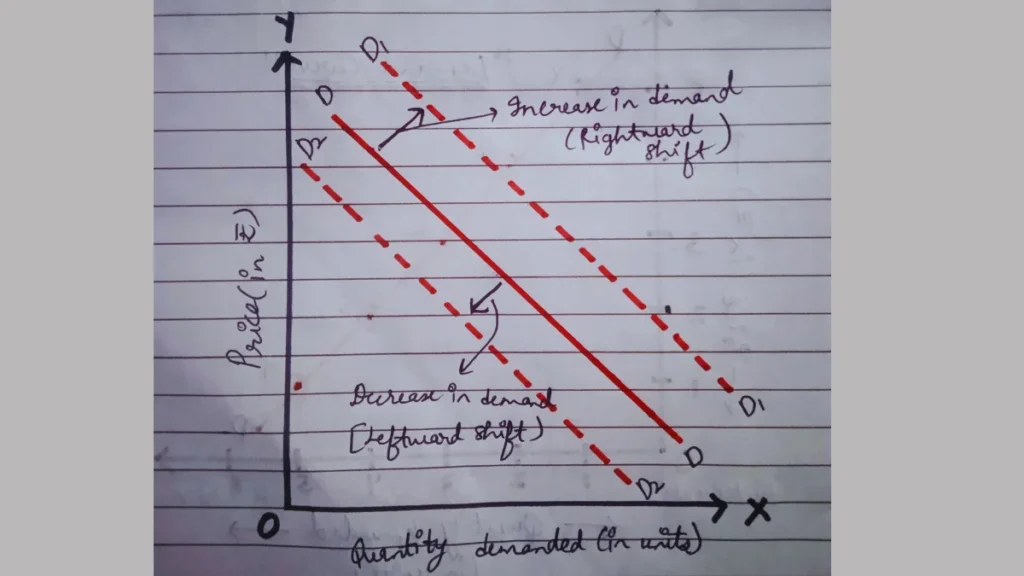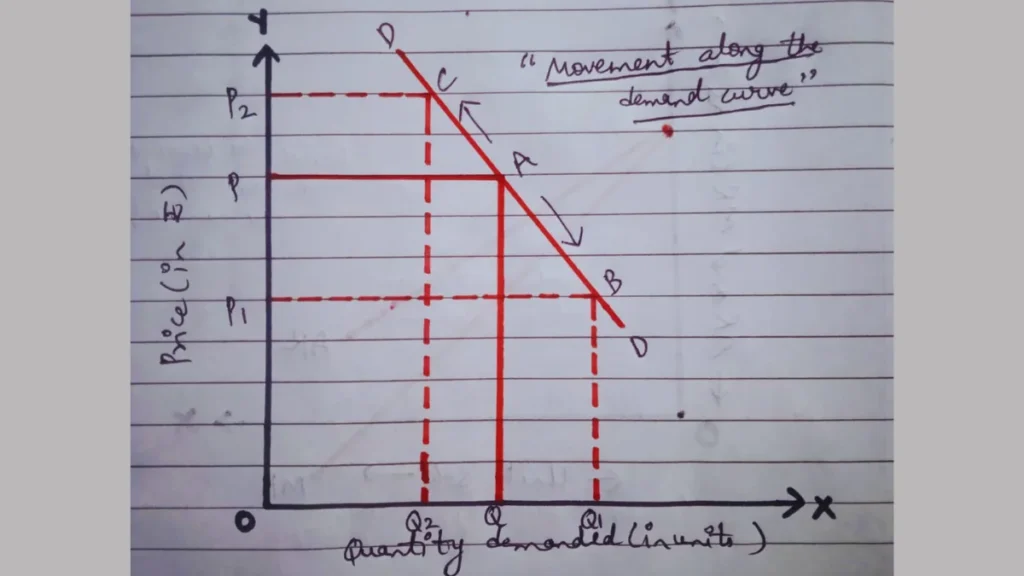Demand is the quantity of a commodity a consumer is willing and able to buy at each possible price during a given period. Here are the theory of demand class 11 notes.
Topics Discussed
Types of Demand

There are two types of demand:
- Individual Demand: It is the quantity of a commodity that a consumer is willing and able to buy at each possible price during a given period.
- Market Demand: It is the quantity of a commodity that all consumers are willing and able to buy at each possible price during a given period.
Determinants of Demand
1) Price of the given commodity
The most important factor affecting demand is the price of the given commodity. Generally, there exists an inverse relationship between price and quantity demand.
It means as price increases quantity demanded falls and vice-versa.
2) Price of the Related Goods
Demand for a given commodity is also affected by changes in the price of related goods.
Related goods are of 2 types:
- Substitute Goods: Those goods which can be used in place of each other to satisfy a particular want.
Demand for a given good is directly affected by a change in the price of substitutes. For example: Coke and Pepsi, Tea and Coffee, etc. - Complementary Goods: Those goods that are used together to satisfy a particular want.
Demand for a given good is inversely affected by a change in the price of complementary goods. For example: Tea and Sugar, Ink and Pen, etc.
3) Income of the Consumer
Demand for a commodity is also affected by the income of the consumer however the effect of a change in income on demand depends on the nature of the commodity.
- If the given commodity is a normal good then an increase in income leads to a rise in its demand whereas a decrease in income reduces its demand.
- If the given commodity is an inferior good then an increase in income reduces the demand while a decrease in income leads to a rise in demand.
4) Taste & Preferences
The taste and preferences of the consumer directly influence the demand for a commodity. They include changes in fashion, habits, etc.
If a commodity is in fashion or is preferred by the consumer, then demand for such a commodity rises whereas demand for a commodity falls if the consumers have no taste for that commodity.
5) Season and Weather
The season & weather conditions also affected the market demand for a commodity.
For example: during winter demand for woolen clothes increases whereas the market demand for raincoats and umbrellas increases during the rainy season.
6) Expectations of Change in Price in the Future
If the prices of a certain commodity are expected to increase shortly then people will buy more of that commodity than what they normally buy.
There exists a direct relationship between the expectation of change in price in the future and change in demand in the current period.
Note: Determinants of market demand are the same as above.
Demand Schedule
A demand schedule is a tabular representation showing various quantities of the commodity being demanded at various levels of price during a given period.
| Price (in rupees) | Quantity Demanded (in units) |
| 5 | 1 |
| 4 | 2 |
| 3 | 3 |
| 2 | 4 |
| 1 | 5 |
Demand Curve

It is a graphical representation of the demand schedule. It shows the inverse relationship between the quantity demanded of a commodity with its price keeping other factors constant.
Note: The market demand curve is a flatter curve as compared to the individual demand curve. It happens because as price changes, proportionate change in market demand is more than proportionate change in individual demand.
Law of Demand
The law of Demand states the inverse relationship between price and quantity demanded, keeping other factors constant. (Ceterus Paribus)
Assumptions of Law of Demand
- The price of substitute goods does not change.
- The price of complementary goods remains constant.
- Income from the consumers remains the same.
- The taste and preferences of the consumer remain the same.
- There is no expectation of a change in price in the future.
Reasons of Law of Demand
1) Law of DMU (Diminishing Marginal Utility)
The Law of DMU states that as we consume more and more units of commodity, the utility derived from each successive unit goes on decreasing.
So, the demand for a commodity depends on its utility. If a consumer gets more satisfaction, he will pay more as a result the consumer will not be prepared to pay the same price for additional units.
The consumer will buy more units of the commodity only if the price falls.
2) Substitution Effect
The substitution effect refers to substituting one commodity in place of the other when it becomes relatively cheaper. When the price of the given commodity falls, it becomes relatively cheaper as compared to its substitutes.
As a result, Demand for the given commodity rises.
3) Income Effect
The income effect refers to the effect on demand when the real income of a consumer changes due to a change in the price of a given commodity.
When the price of a given commodity falls it increases the purchasing power of the consumer. As a result, the consumer can purchase more of the given commodity with the same money income.
4) Additional Customers
When the price of a commodity falls, many new consumers who were not in a position to buy it earlier due to its high price start purchasing it.
In addition to new customers, old consumers of the commodity started demanding more due to its reduced price.
5) Different Uses
Some commodities like milk, electricity, etc have several uses, some of which are more important than others. When the price of such a good increases, its use gets restricted to the most important purpose, and demand for less important uses gets reduced.
However, when the price of such a commodity decreases, the commodity is put to all its uses whether important or not.
Exceptions to the Law of Demand
- Giffen Goods: These are special kinds of inferior goods on which a consumer spends a large part of his income and their demand rises with an increase in price whereas demand falls with a price decrease.
For example: In our country, it is often seen that when the price of coarse cereal like bajra, jowar falls then consumers tend to spend less on them and shift over to superior cereals like wheat and rice. - Status Symbol Goods: Certain prestige goods are used as status symbols. For Example: Diamonds, gold, etc.
These goods are wanted by rich persons for prestige and distinction. The higher the price, the higher the demand for such goods. - Fear of Shortage: If a consumer aspects scarcity of a particular commodity shortly then they would start buying more of that commodity even if the prices are rising.
The consumer demands more due to fear of further rise in prices. - Fashion-related Goods: Goods related to fashion do not follow the law of demand and their demand increases even with the rise in their prices.
For example: If a particular type of dress is in fashion, then demand for such dress will increase even if its prices are rising. - Necessities of Life: Another exception occurs in the use of such commodities which become necessities of life due to their constant use.
For example: Commodities like rice, wheat, medicines, etc. are purchased even at high prices. - Change in Weather: With change in weather, demand for certain commodities also changes, irrespective of any change in their prices.
For example: Demand for umbrellas increases in the rainy season even with the rise in prices.
Change in Quantity Demanded (Movement)

When the quantity demanded of a commodity changes due to a change in its price keeping other factors constant, it is known as a change in quantity demanded.
It is graphically expressed as movement along the same demand curve. There can be either:
1) Downward Movement (Expansion)
2) Upward Movement (Contraction)
Upward Movement (Contraction)
Contraction in demand refers to a fall in quantity demanded due to a rise in the price of the commodity, other factors remaining constant.
It leads to an upward movement along the same demand curve.
| Price (In Rs.) | Qd (In Units) |
| 100 | 200 |
| 150 | 150 |
Downward Movement (Expansion)
Expansion in demand refers to a rise in quantity demanded due to a fall in the price of the commodity, other factors remaining constant.
It leads to downward movement along the same demand curve. It is also known as expansion in demand.
| Price (In Rs.) | Quantity (In Units) |
| 150 | 150 |
| 100 | 200 |
Elasticity of Demand Class 11 Notes
Change in Demand Curve (Shift)

When the demand for a commodity changes due to a change in any factor other than its price, it is known as a change in demand.
It is graphically expressed as a shift in the demand curve. The shift can be rightward or leftward.
Rightward Shift (Increase in Demand)
When the demand for a commodity rises due to any factor other than its price it is known as an increase in demand.
An increase in demand will lead to a rightward shift in the demand curve.
| Price (In Rs.) | Qd (In Units) |
| 20 | 100 |
| 20 | 200 |
Leftward Shift (Decrease in Demand)
When the demand for a commodity falls due to any factor other than its price, it is known as the decrease in demand.
A decrease in demand leads to a leftward shift in the demand curve.
| Price (In Rs.) | Qd (In Units) |
| 20 | 200 |
| 20 | 100 |
Difference Between Movement and Shift
| Basis | Movement | Shift |
| Meaning | When the quantity demanded of a commodity changes due to the change in its own price keeping other factors constant. | When the demand for a commodity changes due to a change in any factor other than its own price. |
| Reason | It is caused by a change in price. | It is caused by a change in any factor other than the own price. |
| Other Name | It is also known as a change in quantity demanded. | It is also known as a change in demand. |
| Price & Other Factors | In this case, other factors remain constant. | In this case, the price remains constant. |
| Types | Movement can be either expansion or contraction. | Shift can be either rightward or leftward. |
These are the theory of demand class 11 notes. If you have any doubts or any suggestions for these notes, you can write your thoughts in the comments section.
[…] Demand Class 11 Notes Microeconomics […]
[…] Theory of Demand Class 11 Notes Economics […]
[…] Theory of Demand Class 11 Notes Economics […]